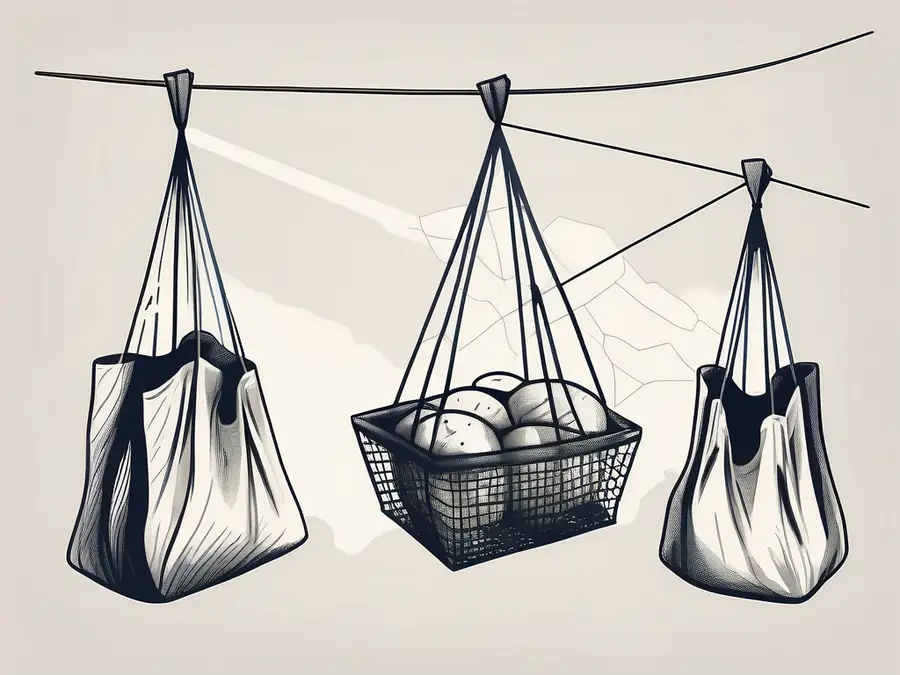What Is a Bagholder? Identifying and Learning from Their Mistakes

Investing in the stock market can be an exciting and potentially lucrative venture. However, it's important to approach it with caution and knowledge to avoid common mistakes that can lead to losses. In this ultimate guide for bagholders, I will share valuable insights and strategies to help you steer clear of costly pitfalls and protect your investments. So let's dive in!
Understanding the Concept of Bagholding
Bagholding, in the investment world, refers to the situation where an investor holds onto a stock that has significantly declined in value, often reluctant to sell for fear of incurring a loss. It's crucial to grasp this concept because it underlies many of the mistakes made by investors.
One aspect to consider when discussing bagholding is the concept of sunk costs. Investors may feel that because they have already invested a significant amount of money into a stock, selling it at a loss would mean admitting defeat. This psychological barrier can lead to irrational decision-making and further losses.
Definition of Bagholding in Investment
Bagholding occurs when an investor continues to hold onto a stock despite it being in a poor performing state. This often happens when emotions such as fear or hope cloud judgment, preventing rational decision-making.
Another factor that contributes to bagholding is the phenomenon of anchoring bias. Investors may fixate on the price at which they purchased the stock, hoping for it to return to that level. This fixation can prevent them from objectively reassessing the stock's current value and potential for future growth.
The Psychology Behind Bagholding
Understanding the psychology behind bagholding is essential to avoid falling into this trap. Bagholders often become emotionally attached to their investments, making it difficult to let go. The fear of losing out on potential gains or the hope that the stock will eventually rebound can blind them to the reality of the situation.
Personal advice: When I first started investing, I held onto a stock that had been plummeting for months. I was emotionally attached to it, convinced that it would eventually recover. However, I learned the hard way that emotions should never dictate investment decisions. It's vital to separate emotions from investments and make decisions based on thorough research and rational analysis.
Identifying Common Mistakes of Bagholders
Now that we understand the concept of bagholding, let's explore some of the common mistakes made by bagholders, so you can avoid them:
Overconfidence in the Market
Overconfidence can be detrimental to your investment success. Many bagholders fall into the trap of thinking they know better than the market, believing their stock picks are infallible. This leads to a lack of caution and proper risk management.
It's important to remember that the market is unpredictable and subject to various external factors beyond our control. Maintaining a humble and cautious approach to investing can help prevent overconfidence and mitigate potential losses in the long run.
Lack of Diversification
Diversification is key to reducing risk in your investment portfolio. Bagholders often make the mistake of putting all their eggs in one basket, investing heavily in a single stock or sector without spreading their investments across a variety of industries. This lack of diversification leaves them vulnerable to significant losses if that stock or sector plummets.
By diversifying your investments across different asset classes, industries, and geographical regions, you can spread out risk and potentially offset losses in one area with gains in another. This strategy not only helps protect your portfolio from market volatility but also allows you to take advantage of various growth opportunities.
Ignoring Market Trends
Ignoring market trends is a common mistake made by bagholders. They may hold onto a stock that has been declining, even when the broader market or sector is moving in the opposite direction. This failure to adapt to changing market conditions can result in missed opportunities and further losses.
Staying informed about market trends and developments is essential for making informed investment decisions. By keeping a close eye on economic indicators, industry news, and technical analysis, investors can better position themselves to capitalize on emerging opportunities and navigate potential risks effectively.
Strategies to Avoid Becoming a Bagholder
Now that we've identified common mistakes, let's explore strategies to help you avoid becoming a bagholder:
Importance of Research in Investing
Thorough research is the foundation of successful investing. Take the time to study the companies you're considering investing in, analyze their financial health, understand their industry dynamics, and evaluate their growth potential. By making informed decisions based on solid research, you can minimize the risk of becoming a bagholder.
Researching a company involves delving into not just its financial statements but also its management team, competitive positioning, and future prospects. Understanding the broader market trends and potential disruptors in the industry can provide valuable insights into the company's sustainability and growth trajectory. Additionally, keeping abreast of macroeconomic factors and geopolitical events can help you anticipate market movements and make more informed investment decisions.
The Role of Patience in Investment
Patience is a virtue in investing. It's essential to have a long-term perspective and not succumb to short-term market fluctuations. By staying patient and allowing your investments to grow over time, you can avoid impulsive decisions driven by short-term emotions.
Developing a disciplined investment strategy that aligns with your financial goals and risk tolerance is key to maintaining patience in the face of market volatility. Diversifying your portfolio across different asset classes and sectors can help spread risk and reduce the impact of market downturns on your overall investment performance. Remember, successful investing is a marathon, not a sprint.
Knowing When to Cut Losses
Knowing when to cut your losses is crucial in avoiding becoming a bagholder. If a stock consistently underperforms, despite your best research and analysis, it may be time to let go. Set predefined stop-loss levels to protect your downside and prevent significant losses from accumulating.
Emotional attachment to a stock can cloud your judgment and lead to holding onto a losing position for too long. Implementing risk management techniques such as trailing stop orders or utilizing options to hedge against downside risk can help you mitigate losses and preserve capital. Remember, it's important to differentiate between short-term price fluctuations and long-term investment thesis when making decisions to cut losses.
Protecting Your Investments
Protecting your investments is paramount to secure your financial future. Consider the following strategies:
The Importance of a Balanced Portfolio
A balanced portfolio is one that is diversified across different asset classes and sectors. By spreading your investments across a variety of stocks, bonds, real estate, and other assets, you can reduce the impact of any single investment underperforming. This diversification helps to spread risk and can potentially enhance returns over the long term. Additionally, a balanced portfolio can help you weather market volatility and economic uncertainties more effectively.
Furthermore, when constructing a balanced portfolio, it's essential to consider your investment goals, time horizon, and risk tolerance. These factors will influence the allocation of assets in your portfolio and ensure that it aligns with your overall financial plan.
Risk Management Techniques
Implementing risk management techniques is crucial for protecting your investments. Set appropriate stop-loss orders, use trailing stops, and consider hedging strategies such as options or futures contracts. These risk management tools can help limit your losses during market downturns and protect your portfolio from unnecessary risks. Moreover, having a clear risk management strategy in place can provide you with peace of mind and confidence in your investment decisions.
The Role of Regular Portfolio Review
Regularly reviewing your portfolio is essential to assess its performance and make necessary adjustments. Rebalancing your portfolio periodically ensures that your investments align with your financial goals and risk tolerance. By reviewing your portfolio on a consistent basis, you can identify any underperforming assets and take proactive measures to address them. This proactive approach can help prevent potential losses and optimize the overall performance of your investment portfolio.
FAQs
Q: What is bagholding?
Bagholding refers to the act of holding onto a stock that has significantly declined in value, often due to emotional attachment or the hope of a future rebound.
When investors find themselves in a situation of bagholding, it can be a challenging position to navigate. The emotional attachment to a stock can cloud judgment and lead to poor decision-making. It is crucial for investors to assess the reasons behind their attachment to a particular stock and evaluate whether holding onto it aligns with their overall investment strategy.
Q: How can I avoid becoming a bagholder?
To avoid becoming a bagholder, conduct thorough research before investing, diversify your portfolio, stay attuned to market trends, have patience, and know when to cut your losses.
Additionally, setting clear investment goals and regularly reviewing your portfolio's performance can help prevent the trap of bagholding. By having a well-defined exit strategy and being disciplined in sticking to it, investors can avoid the pitfalls associated with holding onto underperforming stocks.
Q: How can I protect my investments?
You can protect your investments by maintaining a balanced portfolio, implementing risk management techniques, and regularly reviewing your portfolio to make necessary adjustments.
Furthermore, staying informed about market developments, economic indicators, and geopolitical events can provide valuable insights for protecting your investments. By staying proactive and adaptable to changing market conditions, investors can mitigate risks and safeguard their financial assets.
By following the strategies outlined in this ultimate guide for bagholders, you can navigate the stock market with confidence, avoid common mistakes, and protect your investments for long-term success. Remember, investing is a journey that requires discipline, patience, and continuous learning. Stay informed, stay proactive, and always make decisions based on careful analysis rather than emotions.
As you strive to avoid the pitfalls of bagholding and take control of your investment journey, consider the innovative solutions offered by Morpher. This revolutionary trading platform leverages blockchain technology to provide zero fees, infinite liquidity, and the ability to trade across diverse asset classes. With Morpher, you can engage in fractional investing, short selling without interest fees, and enjoy up to 10x leverage to maximize your trades. Plus, the safety and control of a non-custodial wallet ensure that you're in charge of your investments. Ready to transform your trading experience? Sign Up and Get Your Free Sign Up Bonus at Morpher today and join the future of investing.

Disclaimer: All investments involve risk, and the past performance of a security, industry, sector, market, financial product, trading strategy, or individual’s trading does not guarantee future results or returns. Investors are fully responsible for any investment decisions they make. Such decisions should be based solely on an evaluation of their financial circumstances, investment objectives, risk tolerance, and liquidity needs. This post does not constitute investment advice.

Painless trading for everyone
Hundreds of markets all in one place - Apple, Bitcoin, Gold, Watches, NFTs, Sneakers and so much more.

Painless trading for everyone
Hundreds of markets all in one place - Apple, Bitcoin, Gold, Watches, NFTs, Sneakers and so much more.








